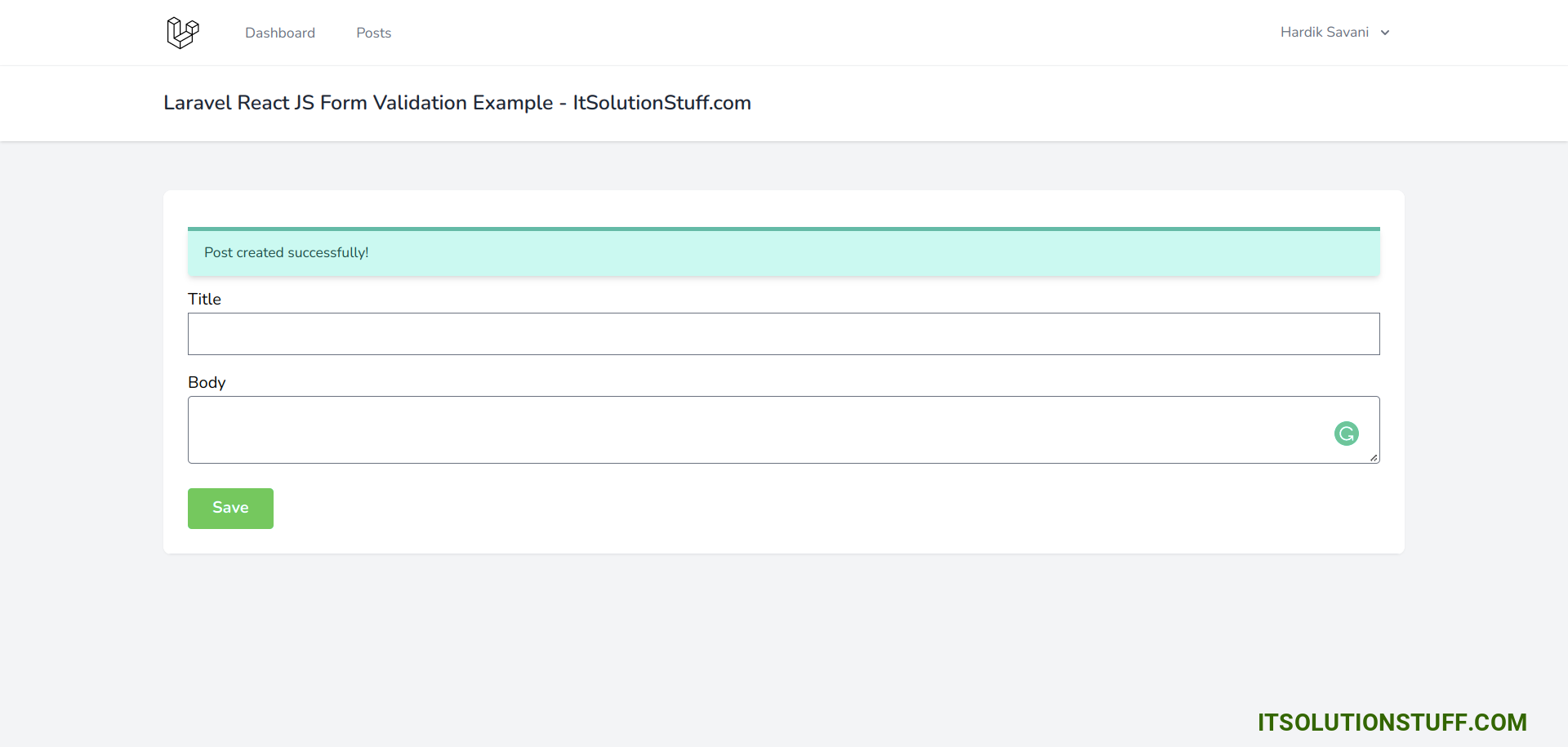Laravel React JS Form Validation Example
Hi Friends,
In this example, you will learn laravel react js form validation. it's a simple example of laravel react js form submit example. We will use laravel 9 react js form validation. This post will give you a simple example of form validation in react js laravel.
You can use this example with laravel 6, laravel 7, laravel 8, laravel 9, laravel 10 and laravel 11 version.
In this tutorial, we will use laravel breeze, inertia js, vite and tailwind CSS to create react form validation in laravel app. we will create "posts" table with title and body columns. then we will create a simple form with validation using react.
So, let's follow the below step to do react js form submit with laravel vite. you can see below a preview screenshot of the example as well.
Preview:

Step 1: Install Laravel
This is optional; however, if you have not created the laravel app, then you may go ahead and execute the below command:
composer create-project laravel/laravel example-app
Step 2: Create Auth with Breeze
Now, in this step, we need to use composer command to install breeze, so let's run bellow command and install bellow library.
composer require laravel/breeze --dev
now, we need to create authentication using bellow command. you can create basic login, register and email verification using react js. if you want to create team management then you have to pass addition parameter. you can see bellow commands:
php artisan breeze:install react
Now, let's node js package:
npm install
let's run vite, you have to keep start this command:
npm run dev
now, we need to run migration command to create database table:
php artisan migrate
Step 3: Create Migration and Model
Here, we need create database migration for posts table and also we will create model for posts table.
php artisan make:migration create_posts_table
Migration:
<?php
use Illuminate\Database\Migrations\Migration;
use Illuminate\Database\Schema\Blueprint;
use Illuminate\Support\Facades\Schema;
return new class extends Migration
{
/**
* Run the migrations.
*
* @return void
*/
public function up()
{
Schema::create('posts', function (Blueprint $table) {
$table->id();
$table->string('title');
$table->text('body');
$table->timestamps();
});
}
/**
* Reverse the migrations.
*
* @return void
*/
public function down()
{
Schema::dropIfExists('posts');
}
}
php artisan migrate
now we will create Post.php model by using following command:
php artisan make:model Post
App/Models/Post.php
<?php
namespace App\Models;
use Illuminate\Database\Eloquent\Factories\HasFactory;
use Illuminate\Database\Eloquent\Model;
class Post extends Model
{
use HasFactory;
/**
* The attributes that are mass assignable.
*
* @var array
*/
protected $fillable = [
'title', 'body'
];
}
Step 4: Create Route
In third step, we will create routes for react js form submit. so create two routes here.
routes/web.php
<?php
use Illuminate\Foundation\Application;
use Illuminate\Support\Facades\Route;
use Inertia\Inertia;
use App\Http\Controllers\PostController;
/*
|--------------------------------------------------------------------------
| Web Routes
|--------------------------------------------------------------------------
|
| Here is where you can register web routes for your application. These
| routes are loaded by the RouteServiceProvider within a group which
| contains the "web" middleware group. Now create something great!
|
*/
Route::get('posts/create', [FileController::class, 'create'])->name('posts.create');
Route::post('posts/create', [FileController::class, 'store'])->name('posts/store');
Route::get('/', function () {
return Inertia::render('Welcome', [
'canLogin' => Route::has('login'),
'canRegister' => Route::has('register'),
'laravelVersion' => Application::VERSION,
'phpVersion' => PHP_VERSION,
]);
});
Route::get('/dashboard', function () {
return Inertia::render('Dashboard');
})->middleware(['auth', 'verified'])->name('dashboard');
require __DIR__.'/auth.php';
Step 5: Create Controller
In this step, we will create PostController file and add following code on it.
app/Http/Controllers/PostController.php
<?php
namespace App\Http\Controllers;
use Illuminate\Http\Request;
use Inertia\Inertia;
use App\Models\Post;
use Illuminate\Support\Facades\Validator;
class PostController extends Controller
{
/**
* Write code on Method
*
* @return response()
*/
public function create()
{
return Inertia::render('Posts/Create', [
'message' => session('message'),
]);
}
/**
* Show the form for creating a new resource.
*
* @return Response
*/
public function store(Request $request)
{
Validator::make($request->all(), [
'title' => ['required'],
'body' => ['required'],
])->validate();
Post::create($request->all());
return redirect()->route('posts.create')
->with('message', 'Post created successfully!');
}
}
Step 6: Create React Pages
Here, in this step we will create Create.jsx file with form.
so, let's create it and add bellow code on it.
resources/js/Pages/Posts/Create.jsx
import React from 'react';
import Authenticated from '@/Layouts/Authenticated';
import { Head, useForm, Link, usePage } from '@inertiajs/inertia-react';
export default function Dashboard(props) {
const { message } = usePage().props
const { data, setData, errors, post } = useForm({
title: "",
description: "",
});
function handleSubmit(e) {
e.preventDefault();
post(route("posts.store"));
data.title = "";
data.body = "";
}
return (
<Authenticated
auth={props.auth}
errors={props.errors}
header={<h2 className="font-semibold text-xl text-gray-800 leading-tight">Laravel React JS Form Validation Example - ItSolutionStuff.com</h2>}
>
<Head title="Posts" />
<div className="py-12">
<div className="max-w-7xl mx-auto sm:px-6 lg:px-8">
<div className="bg-white overflow-hidden shadow-sm sm:rounded-lg">
<div className="p-6 bg-white border-b border-gray-200">
{ message &&
<div className="bg-teal-100 border-t-4 border-teal-500 rounded-b text-teal-900 px-4 py-3 shadow-md my-3" role="alert" >
<div className="flex">
<div>
<p className="text-sm">{ message }</p>
</div>
</div>
</div>
}
<form name="createForm" onSubmit={handleSubmit}>
<div className="flex flex-col">
<div className="mb-4">
<label className="">Title</label>
<input
type="text"
className="w-full px-4 py-2"
label="Title"
name="title"
value={data.title}
onChange={(e) =>
setData("title", e.target.value)
}
/>
<span className="text-red-600">
{errors.title}
</span>
</div>
<div className="mb-0">
<label className="">Body</label>
<textarea
type="text"
className="w-full rounded"
label="body"
name="body"
errors={errors.body}
value={data.body}
onChange={(e) =>
setData("body", e.target.value)
}
/>
<span className="text-red-600">
{errors.body}
</span>
</div>
</div>
<div className="mt-4">
<button
type="submit"
className="px-6 py-2 font-bold text-white bg-green-500 rounded"
>
Save
</button>
</div>
</form>
</div>
</div>
</div>
</div>
</Authenticated>
);
}
Run Laravel App:
All the required steps have been done, now you have to type the given below command and hit enter to run the Laravel app:
php artisan serve
Also keep run following command for vite:
npm run dev
If you want to build then you can run following command:
npm run build
Now, Go to your web browser, type the given URL and view the app output:
http://localhost:8000
Then after you have to go to the below URL:
http://localhost:8000/posts/create
now it works...
I hope it can help you...

